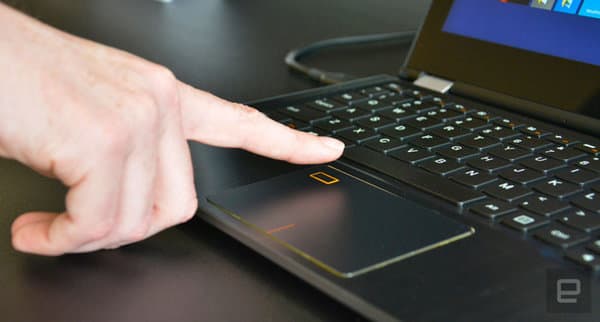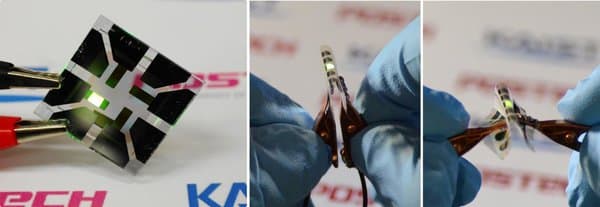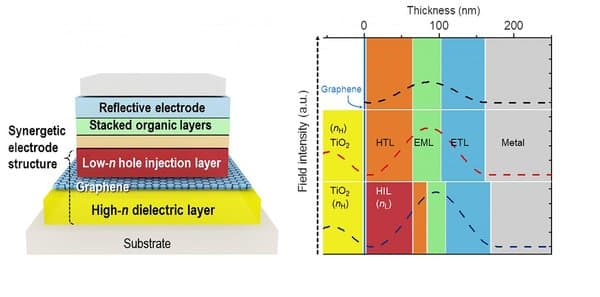Conincidence: World Beholds KAIST Made Graphene OLEDs while Apple Sports OLED Display In Touch Panel
A news outbreak, pertaining to Apple MacBook Pro has cloaked the world in virulent “expectationâ€. Rumors are doing the rounds that the “gadget magiciansâ€, Apple would soon refurbish their hardware architecture with a set of modifications significantly improving touch panel and keyboard systems. Authorized press release and other 3rd party sources claim, WWDC 16 might witness Apple MacBook Pro with an OLED display touch bar implanted above the functional keys coupled with performance boosting features and Touch ID security panel. With strong support, as they already seem true, it might rejuvenate Apple enthusiasts to put a bet on it (mind, you must be heavy on pocket).

Apprehensively, (partially decisive) CE world in here might smell a telepathic connection with such large modifications going in Apple incubation center, which could be soon be releasing the first non-iOS biometric security module with recent advancements in Graphene based flexible OLEDs at politically tied-up-in-good-terms country based institute The Korea Advanced Institute of Science and Technology (KAIST). However, the results produced in the process is much more sophisticated and complex than what has been offered in Apple MacBook Pro 2016. Saluting the former, let’s concentrate on futuristic development of computers that certainly speaks about OLEDs and their spells over electronics.
Scientists at KAIST have recently designed a flexible sheet, just like a sticker, which is claimed to be the world’s most flexible computer. Can you think of rolling your keyboard and screen? Can you bind it up like a chart paper with a rubber band and put inside your bag? Can you simply stick it up in wall while you are resting on your favorite couch? These may seem pretty vague and more paper-ish, but that is now possible with flexible Organic Light Emitting Diodes, the future of malleable display technologies.
A team with joint leaders, Professor Seunghyup Yoo from the School of Electrical Engineering, KAIST and Professor Tae-Woo Lee from the Department of Materials Science and Engineering, Pohang University of Science and Technology (POSTECH) has engineered OLEDs with high degree of flexibility fused with honey-comb shaped magic material graphene (working as transparent electrodes) placed in between titanium dioxide (TiO2) and conducting polymer layers.

OLED with the composite structure
As informed, the structures of such thin computers are basically a column of 5 layers glued over one another. OLEDs are implanted in stacked plastic or oil substrates which are further pushed between multilayers of electrodes (cathodes + anodes). While voltage is applied, cathode releases electrons and anode, holes (+ve charges) which prompts OLEDs to emit light, photon in form of energy, as a result of recombination taking place in emissive layer. Either cathode or anode is made reflective which further decides the direction, top or bottom, from which OLED will shower light.
In general, bottom-based OLEDs are used where anodes are specifically set to be transparent. In that case Indium-tin-oxide (ITO) is used to prepare transparent anodes for is high transparency and low sheet resistance. Another important product corresponding to its mechanical design is the honeycomb lattice based Graphene with significant electrical, physical, and chemical properties makes it the best choice for Transparent Electrodes (TEs). After the initial integration the team proposed another structure with transparent anode in a composite fabrication where TiO2 layer with a high refractive index (high-n) and a hole-injection layer (HIL) of conducting polymers with a low refractive index (low-n) are embedded on the two sides of stacked graphene layers.

Source: #-Link-Snipped-#| With Touch ID rumored for Apple's new MacBook Pros, PC makers prep trackpad fingerprint readers | AppleInsider

Apprehensively, (partially decisive) CE world in here might smell a telepathic connection with such large modifications going in Apple incubation center, which could be soon be releasing the first non-iOS biometric security module with recent advancements in Graphene based flexible OLEDs at politically tied-up-in-good-terms country based institute The Korea Advanced Institute of Science and Technology (KAIST). However, the results produced in the process is much more sophisticated and complex than what has been offered in Apple MacBook Pro 2016. Saluting the former, let’s concentrate on futuristic development of computers that certainly speaks about OLEDs and their spells over electronics.
Scientists at KAIST have recently designed a flexible sheet, just like a sticker, which is claimed to be the world’s most flexible computer. Can you think of rolling your keyboard and screen? Can you bind it up like a chart paper with a rubber band and put inside your bag? Can you simply stick it up in wall while you are resting on your favorite couch? These may seem pretty vague and more paper-ish, but that is now possible with flexible Organic Light Emitting Diodes, the future of malleable display technologies.
A team with joint leaders, Professor Seunghyup Yoo from the School of Electrical Engineering, KAIST and Professor Tae-Woo Lee from the Department of Materials Science and Engineering, Pohang University of Science and Technology (POSTECH) has engineered OLEDs with high degree of flexibility fused with honey-comb shaped magic material graphene (working as transparent electrodes) placed in between titanium dioxide (TiO2) and conducting polymer layers.

OLED with the composite structure
In general, bottom-based OLEDs are used where anodes are specifically set to be transparent. In that case Indium-tin-oxide (ITO) is used to prepare transparent anodes for is high transparency and low sheet resistance. Another important product corresponding to its mechanical design is the honeycomb lattice based Graphene with significant electrical, physical, and chemical properties makes it the best choice for Transparent Electrodes (TEs). After the initial integration the team proposed another structure with transparent anode in a composite fabrication where TiO2 layer with a high refractive index (high-n) and a hole-injection layer (HIL) of conducting polymers with a low refractive index (low-n) are embedded on the two sides of stacked graphene layers.

Schematic diagram of OLED structure
This ultra-tech design gives number of benefits which perfectly suits the requirement. Firstly, optical cavity resonance effect gets maximized which in turn tunes the color spectrum of OLED display. Plus, a reduced loss of surface-plasmon-polariton (a synchronized wave of plasma quanta plasmon and vibration quanta polariton) which helps to brighten the screen. All together the synergistic collaboration between high-low index layers have carved to gather the maximum advantages. With such devices, we could now imagine how the world could actually change in next 10 years and how evolution would probably merge with instruments to envision the perfect world. The related research is recently published in “Nature†Journal.
Source: #-Link-Snipped-#| With Touch ID rumored for Apple's new MacBook Pros, PC makers prep trackpad fingerprint readers | AppleInsider
Replies
You are reading an archived discussion.
Related Posts
I'm reading about JSON data type support in MariaDB and wondering if it specifically addresses the data search issue. For example:
-----------------------------------------------------------------------
ID | Table1 | Table 2 | Table...
Quote:
We tend to think of learning a new skill or "going back to school" as something you'd do when looking to change careers, or to upgrade within your current...
Quote:
It might be possible someday to "breed" robots, allowing the robots themselves to select out what traits are most "attractive" in environments with unanticipated challenges.
That is the tantalizing...
For the last half a decade, flexible OLED displays gained more popularity than what was anticipated. The big players, especially Samsung and LG were the one of the few well...
Hi ,
Im using DRAFTSIGHT software which is almost similar to AUTOCAD.Coming to the point I had drawn 20 drawings in a sheet and given a specific number to each...
